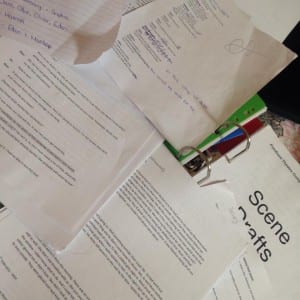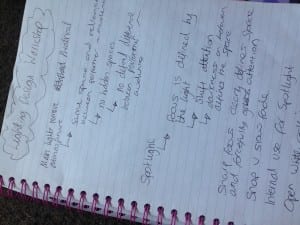“Creating an original performance, as opposed to staging a play, inevitably involves drawing upon a personal experience or reframing pre-existing within a collectively designed structure.”
(Govan et al, 2007)
As a company there was a decision for us to devise our first performance as a company instead of just staging a play. Within this process we decided we would have writers, to help collect material for us to devise from and also to generate a script, to provide structure to the piece. The performance would have a particular verbatim feel, in which we would use other people’s stories and our own to create a piece. This choice of devising would be difficult for me as stage manager as things could change multiple of times, in order for this not to be a problem, organisation is key! Every scene created, even ones which may not be used, I have stored and kept, by doing so this helps keep track of where our performance started and process it will take to get a final performance. During every rehearsal I take notes down and any lighting or sound ideas that are suggested from the director or even some of my own. As assistant director, I can use all of this information to direct and devise a scene from what the cast like and enjoy to their dislikes. The devising process as Govan puts forward above, I feel describes the process that our piece has taken, we will using our own personal experiences and others to devise from.
(Stage Manager Folder from Kearns 2015)
The choice to use verbatim within our piece also means as stage manager, there needs to be a method of which you can differentiate between the verbatim stories and the other bits that make up the performance. To help me accomplish this I took part in a lighting workshop provided by Darren Page, Lincoln Performing Arts Centre Stage Manager. Through doing so I was able to explore the different ways lighting can be used in order to create different effects. For example the use of spotlights and the different colour gels that can be used to create different feelings and emotions on stage. A particular example that stood out for me was the use of a blue gel light and a white light to create a very clinical feel and the impression that a memory is being created. It’s ideas and experiments like this that help contribute to the devising process also.
If you want to see more, then come see the performance! It’s called Shoes to Fill and is being performed at Lincoln Performing Arts Centre at 19:30pm on MONDAY 18TH MAY!!
Hope to see you there!!
Works Cited:
Govan, E., Nicholson, H. and Normington, K. (2007) Making a performance: devising histories and contemporary practices. [online] London: Routledge . Available from: https://www-dawsonera-com.proxy.library.lincoln.ac.uk/readonline/9780203946954/startPage/64 [Accessed 25th April 2015].
Kearns, E (2015) Stage Manager Folder

